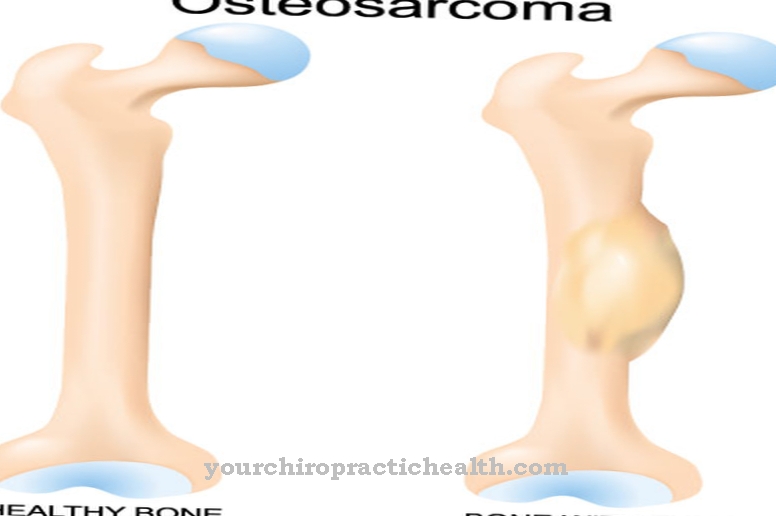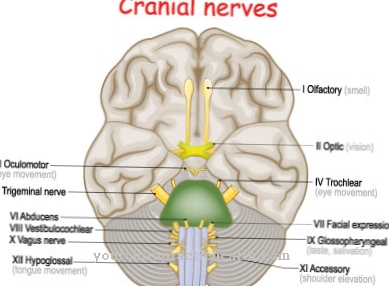Under a carbuncle Doctors understand a deep and usually very painful suppuration of several hair follicles that grow together to form a purulent knot. Mostly a bacterial infection is responsible for the inflammation. Carbuncle must be given medical attention to prevent the bacteria from spreading.
What is a carbuncle?

© commecicommeca - stock.adobe.com
A carbuncle is a painful, purulent adhesion of several adjacent hair follicles. Hair follicles consist of the respective hair root and the sebum gland. If they become infected, experts speak of a boil. Particularly in people who are weakened by age or illness, several boils can grow together, known as carbuncle.
A carbuncle manifests itself as a red and clearly warmed swelling that is later filled with pus, which is usually very painful. In principle, carbuncles can appear all over the body. However, they are particularly common on the buttocks, in the groin, in the armpit or in the neck.
causes
A carbuncle and the preceding boil is also caused by a bacterial infection. Mostly it is the bacterium Staphylococcus aureus, which penetrates the skin through a so-called smear infection.
The resulting infection is a defense reaction of the body, which wants to fight the bacteria. Certain previous illnesses that weaken the organism can promote the development of one or more boils and thus also a carbuncle.
These include AIDS, diabetes and other diseases that affect the person's immune system. Poor personal hygiene and the associated clogged pores can also contribute to boils or even carbuncles.
Symptoms, ailments & signs
The boils initially appear as small, mostly reddish and painful bumps. The bumps can appear all over the body. As the disease progresses, they fill with pus and develop oozing or crusty growths. Over the course of a few days, the carbuncles increase in size and spread to neighboring regions of the body.
Eventually the boils break open and a thick, usually white or reddish liquid emerges. With a superficial carbuncle, there is a risk of scar formation. Deep-seated growths can leave large skin changes and are often accompanied by symptoms. Larger or multiple carbuncles can often lead to fever and general malaise.
Affected people feel sick and exhausted, and the pain and itchiness greatly reduce their wellbeing. Externally, carbuncle also shows up as a swelling in the surrounding tissue. Usually the lymph nodes of the neck, groin or armpit are also affected by swelling. If left untreated, the boil can cause further complications. In the worst case scenario, blood poisoning or neurological complaints can occur, depending on the regions of the body to which the pathogens are transported.
Diagnosis & course
A carbuncle can usually be diagnosed by the attending physician simply by looking at the purulent swelling and talking to the patient in detail. In addition, a smear can be taken to determine the exact pathogen.
Palpation of the skin and lymph nodes can help determine the extent of the inflammation. A boil or carbuncle should always be treated by a doctor, as without appropriate therapy it can lead to an infection of the lymph vessels or even blood poisoning.
If boils and carbuncles appear on the face, the bacteria can migrate to the brain and trigger a thrombosis there, which puts the patient's life at risk.
Complications
A carbuncle must always be examined and treated by a doctor. If there is no treatment, the bacteria can spread to other regions of the body. In the worst case, blood poisoning can also occur. Without treatment, this usually leads to the death of the patient and can significantly reduce life expectancy.
The bacteria can continue to spread to the brain and thus lead to paralysis or other neurological complaints. These can result in further restrictions in the patient's everyday life. In many cases, the carbuncle does not need treatment if it is relatively small and heals on its own. If it does not heal itself, antibiotics and other drugs can also be used to alleviate the symptoms.
Likewise, the person concerned is usually dependent on bed rest and suffers from reduced resilience. Increased personal hygiene is often necessary so that carbuncle does not develop again. The right treatment does not reduce life expectancy and there are still no particular complications.
When should you go to the doctor?
If a painful skin change is noticed, a doctor should always be consulted. Inflammation, bleeding or circulatory disorders require a quick examination by the family doctor. Neurological complaints indicate that the pathogens have already spread to the brain and should therefore be clarified quickly. The affected person should also see a doctor if the symptoms intensify rapidly or if there are other unusual symptoms.
If you have an abscess on your face, you should always see a doctor as a precaution. If other symptoms occur, such as fever or chills, medical advice is also required. If there is a reddish stripe running from the abscess towards the heart, there may be blood poisoning. Here, too, the person concerned must visit a practice or hospital immediately. Children should be taken to the pediatrician with a hair follicle. A doctor should do a check-up a few days after the carbuncle is removed. The appropriate doctor is the dermatologist or a general practitioner.
Treatment & Therapy
If a purulent swelling occurs, is it a boil or even a boil? carbunclethe patient must never manipulate it himself. Expressing it, for example, can cause the pathogens to spread further and the condition worsen significantly.
Small boils often heal on their own. A carbuncle, on the other hand, should always be treated by a doctor to prevent complications. If the swelling is particularly large or deep, the attending physician can, for example, decide to surgically open the carbuncle.
The pus is drained and the pus cavity is disinfected to prevent the infection from spreading again. In addition, antibiotics can help fight the bacteria responsible. If surgical opening is not necessary, antibiotics and a so-called pull ointment alone can be used. Wet envelopes can also help, as can wearing light, loose clothing.
Abscesses on the face are usually only treated with medication; the patient then has to stay in bed to prevent the bacteria from migrating into the brain. If boils and carbuncles occur repeatedly, the doctor will examine the patient more closely to determine the cause of the infection.
Outlook & forecast
The prognosis is favorable for a carbuncle. If the person concerned goes for medical treatment, a fight against the pathogens is initiated through medical care. By giving medicines, the existing bacteria are fought and the symptoms are alleviated. Usually no further visit to the doctor is necessary, so that within a few days or weeks you will be completely free of symptoms.
If unforeseeable complications arise due to certain active ingredients of the prescribed preparations, the treatment plan must be optimized. Various preparations are available to the doctor that can be exchanged. Healing delays are possible, but in most cases there will still be no symptoms.
Without the assistance of a doctor, the pathogens can be expected to spread in the organism. In most cases, the functioning of the body's own defense system is not sufficient to adequately defend itself against a multiplication of the bacteria. Complaints increase and the general health of the person concerned deteriorates.
Although the prognosis for a carbuncle is favorable, the symptoms can recur at any time in the course of life. If medical care is sought as quickly as possible, the prognosis can be described as favorable even if the symptoms break out again.
prevention
The creation of a Carbuncle can in many cases be prevented through strict personal hygiene and a healthy lifestyle. However, should boils develop due to a weakened immune system, these should be treated appropriately to prevent the formation of a painful and potentially dangerous carbuncle.
Therefore, boils should always be examined by a doctor, even if they initially appear harmless to the person concerned. This is especially true for abscesses that appear on the face.
Aftercare
The purpose of follow-up care is to ensure that a new disease is detected at an early stage. That is why it is used especially for cancer. Doctors promise better treatment options from this. However, this aspect does not play a role in the treatment of carbuncle. A carbuncle can reappear at any time due to an external bacterial case, but after healing it cannot be caused by the initial infection.
Patients can protect themselves in everyday life with self-responsible aftercare measures. This includes avoiding nicotine consumption and adequate hygiene. The attending physician will provide information about possible protective measures during the initial therapy. In addition, aftercare aims to provide everyday support so that the patient can lead a life that is as symptom-free as possible.
Treatment for carbuncles sometimes leaves scars. If these remain in a visible place, they can represent a psychological burden. Psychotherapy can then strengthen self-confidence as part of the aftercare. Complications and irreparable damage usually arise when carbuncle was treated late.
Blood poisoning transports the pathogens to other parts of the body. Neurological disorders and altered brain activities can make long-term treatment necessary. Suitable therapies are based on the symptoms and are agreed individually. Aids and medication may have to be used.
You can do that yourself
A carbuncle doesn't necessarily need to be treated by a doctor. The bump will usually heal on its own after a few days if it is washed and kept clean regularly. It is important to boil towels, rags or items of clothing after contact with the growth. Physical contact with other people should be avoided temporarily.
The healing can be supported by various home remedies and measures. Warm compresses that are applied to the carbuncle two to three times a day for 20 minutes each time have proven useful. Honey relieves itching and can also be applied in the form of a compress or the classic ointment. In general, measures that strengthen the immune system also help: regular exercise, a change in diet or intestinal rehabilitation. Belladonna is an effective remedy from homeopathy. Ointments and gels with arnica help against swelling, while pain is best treated with Hepar sulfuris.
After the boil has opened, the healing process can be supported by St. John's wort. If the carbuncle has not disappeared after one to two weeks at the latest, a visit to the doctor is recommended

.jpg)



.jpg)


.jpg)



















